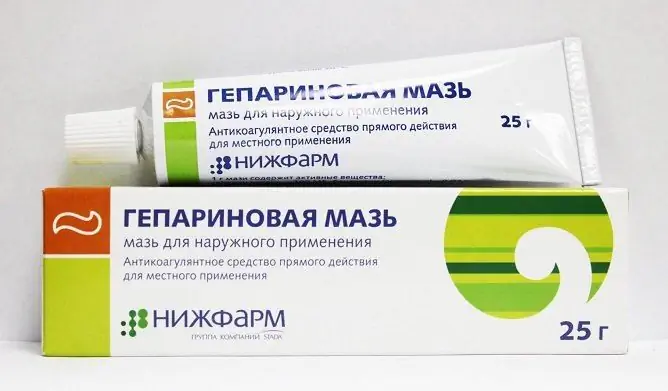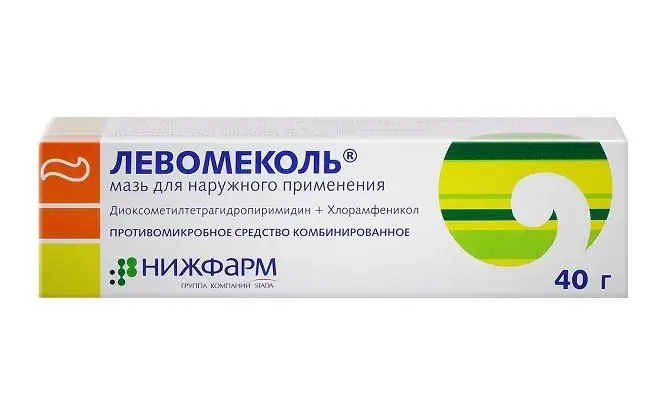- Author Rachel Wainwright [email protected].
- Public 2023-12-15 07:39.
- Last modified 2025-11-02 20:14.
Lorinden A
Latin name: Lorinden A
ATX code: D07XB01
Active ingredient: salicylic acid (Salicylic Acid) + flumethasone (Flumetasone)
Producer: Pharmaceutical Works Jelfa, SA (Poland)
Description and photo update: 2019-02-09
Prices in pharmacies: from 383 rubles.
Buy

Lorinden A is an external preparation with keratolytic and anti-inflammatory effects.
Release form and composition
Lorinden A is produced in the form of an ointment for external use: oily, soft, white with a light yellow tint (in 15 g aluminum tubes, 1 tube in a cardboard box and instructions for use of Lorinden A).
The composition of 100 mg ointment contains active substances:
- Flumethasone pivalate - 0.02 mg;
- Salicylic acid - 3 mg
Auxiliary components: propylene glycol - 5 mg, lanolin - 5 mg, petroleum jelly - up to 100 mg.
Pharmacological properties
Pharmacodynamics
Lorinden A is a combined external preparation with keratolytic and anti-inflammatory effects.
Flumethasone pivalate, which is part of the ointment, is a synthetic glucocorticosteroid. It has anti-edema, anti-inflammatory, antipruritic and anti-allergic effects.
The main effects of the substance:
- Inhibition of the activity of phospholipase A 2, as a result of which the synthesis of leukotrienes and prostaglandins is suppressed, inhibition of the release of inflammatory mediators is noted;
- Prevention of marginal accumulation of neutrophils, due to which inflammatory exudate, cytokine production and inhibition of macrophage migration are reduced, which leads to a decrease in infiltration and granulation processes;
- Promotion of inhibition of migration of lymphocytes and leukocytes to the inflammation focus;
- Reduction of hyperemia, manifestations of hypersensitivity reactions, proliferative and exudative processes that occur in the connective tissues in the focus of inflammation;
- Inhibition of the proteolytic activity of tissue kinins, inhibition of the growth of fibroblasts, inhibition of the development of connective tissue in the focus of inflammation.
Salicylic acid is a non-steroidal anti-inflammatory agent. Its action is aimed at the penetration of flumethasone, which gives Lorinden A an additional moderate keratolytic, antiparakeratosis and local hypothermic properties, and promotes the penetration of flumethasone into the skin. Salicylic acid also suppresses the secretion of the sebaceous and sweat glands, has an antibacterial and fungicidal effect and helps to restore the protective function of the skin.
Pharmacokinetics
The absorption of flumethasone in children is higher than in adults. The absorption of the substance increases when applied under occlusive dressings, on the face, in the area of skin folds, on skin with damaged epidermis and skin that is affected by an inflammatory process, when applied to large areas (in this case, flumethasone can have a systemic effect).
Due to the external method of application and due to the keratolytic effect of salicylic acid, flumethasone easily penetrates into the upper layer of the epidermis through the keratinized layers of the skin, where the substance accumulates.
In the skin, flumethasone is practically not metabolized. After insignificant absorption into the systemic circulation, flumethasone is biotransformed in the liver.
Excretion is carried out with urine and, to a lesser extent, with bile in the form of compounds with glucuronic acid. A small amount of the substance is excreted unchanged.
Indications for use
Lorinden A ointment is prescribed for the treatment of allergic dermatoses (acute and chronic), especially those occurring with excessive keratinization of the skin:
- Diffuse neurodermatitis;
- Atopic dermatitis;
- Chronic lichen Vidal;
- Hyperkeratosis (eg, ichthyosis);
- Verrucous lichen;
- Subacute and chronic eczema in various forms (especially horny);
- Discoid lupus erythematosus;
- Chronic dyshidrosis;
- Otitis externa;
- Photodermatitis;
- Psoriasis;
- Lichen planus;
- Seborrhea;
- Blistering skin diseases, including blistering rashes on the skin of the feet and palms (along with other drugs);
- Erythema multiforme exudative;
- Prurigo with severe lichenification;
- Insect bites.
Contraindications
- Fungal, bacterial and viral skin diseases, including chickenpox, shingles;
- Rosacea and acne vulgaris;
- Subacute exudative and acute weeping stages of skin diseases;
- Lupus;
- Cutaneous manifestations of syphilis;
- Precancerous skin conditions;
- Skin neoplasms;
- Trophic ulcers of the legs associated with varicose veins;
- Pregnancy (I trimester);
- Breast and younger age;
- Hypersensitivity to drug components.
Lorinden A should be used with caution in the presence of atrophic skin changes, especially in elderly patients.
Lorinden A, instructions for use: method and dosage
Lorinden A ointment is applied externally, applying a thin layer 2-3 times a day on the affected area. After the relief of acute inflammation, the frequency of application of the drug is reduced to 1-2 times a day.
After the complete disappearance of the symptoms of the disease, therapy should be continued for another 3-4 days. Chronic skin lesions should not be treated for more than 21 days.
Lorinden A can also be used as an occlusive dressing that is changed every 24 to 48 hours.
When treating lesions on fat-free and dry areas of the skin, which are characterized by severe lichenification, infiltration, desquamation and hyperkeratosis, as well as calcification, the degree of moisture can be adjusted using the thickness of the applied layer (individually, in accordance with therapeutic requirements).
Side effects
- Local reactions: itching, burning, dry skin; with prolonged therapy - telangiectasia, skin atrophy, local hirsutism, perioral dermatitis, purpura, steroid acne, pigmentation disorders;
- Systemic reactions: with prolonged therapy, application to large areas of the skin and / or the use of occlusive dressings - side effects characteristic of glucocorticosteroid therapy; when applied to the skin of the eyelids (hereinafter, sometimes) - cataract or glaucoma.
Overdose
Overdose is possible in case of prolonged use of Lorinden A on large areas of the skin.
Main symptoms: systemic manifestations of glucocorticosteroids - hypercortisolism. In this case, gradual withdrawal of the drug under medical supervision is recommended.
Data on overdose of salicylic acid with its external use were not recorded.
special instructions
It is contraindicated to apply Lorinden A on the face. Care must be taken to ensure that the ointment does not get on the conjunctiva and mucous membranes.
It is not recommended to exceed the duration of the prescribed course of therapy, since with prolonged use of the ointment on large areas of the skin, the frequency of side effects increases.
With the development of infection at the site of application of the ointment, it is necessary to apply funds with a more pronounced antifungal or antibacterial effect.
It is necessary to avoid repeated application of the ointment to large areas of the skin in patients with severe renal failure (due to the possible systemic effect of the active substance - salicylic acid).
The ointment does not contaminate bed linen and clothes.
Application during pregnancy and lactation
In the first trimester of pregnancy, the use of Lorinden A is contraindicated.
During pregnancy, therapy can be carried out as an exception, on limited areas of the skin and only in cases where the intended benefit to the mother is higher than the potential risk to the fetus.
During lactation, short-term use of Lorinden A is possible in exceptional cases on limited areas of the skin; applying ointment to the mammary glands is contraindicated.
Pediatric use
For infants and young children (up to 2 years old), it is contraindicated to use Lorinden A ointment.
In children, therapy is possible only with a short course on small surfaces of the body only if absolutely necessary.
The use of Lorinden A in childhood can cause, in addition to side effects in adults, the following negative reactions: Itsenko-Cushing's syndrome, inhibition of the hypothalamic-pituitary-adrenal system, growth retardation, lag in weight gain, increased intracranial pressure (due to the content of flumethasone).
With impaired renal function
In severe renal failure, the application of Lorinden A to large areas of the skin should be avoided, due to the possible systemic effect of salicylic acid.
Drug interactions
It is contraindicated to carry out immunization and vaccination while using Lorinden A (due to its immunosuppressive effect).
It is not recommended to use Lorinden A together with other external medicines.
The risk of side effects increases when co-administered with the following drugs: diuretics, androgens, oral contraceptives, estrogens, anabolic steroids, bukarban, antipsychotics, azathioprine, anticholinergics, antihistamines, nitrates, tricyclic antidepressants, cardiac glycosides.
In the case of systemic absorption, Lorinden A lowers the effect of oral hypoglycemic agents, insulin, anticoagulants, antihypertensive drugs, and also reduces the concentration of praziquantel in the blood serum.
Analogs
Analogs of Lorinden A are: Flumethasone pivalate, Lorinden, Lorinden C, Dexamethasone, Prednisolone, Diprospan, Methylprednisolone.
Terms and conditions of storage
Keep out of reach of children at temperatures up to 25 ° C.
The shelf life is 3 years.
Terms of dispensing from pharmacies
Dispensed by prescription.
Reviews about Lorinden A
Reviews about Lorinden A are mostly positive. The drug is used for various indications, most often it has high efficiency and good tolerance. Indicate that the ointment does not leave marks on clothes and bed. The disadvantages are the high cost and the impossibility of long-term use.
Price for Lorinden A in pharmacies
The approximate price for Lorinden A (1 tube of 15 g) is 313-403 rubles.
Lorinden A: prices in online pharmacies
|
Drug name Price Pharmacy |
|
Lorinden A ointment 15g 383 r Buy |

Maria Kulkes Medical journalist About the author
Education: First Moscow State Medical University named after I. M. Sechenov, specialty "General Medicine".
Information about the drug is generalized, provided for informational purposes only and does not replace the official instructions. Self-medication is hazardous to health!






